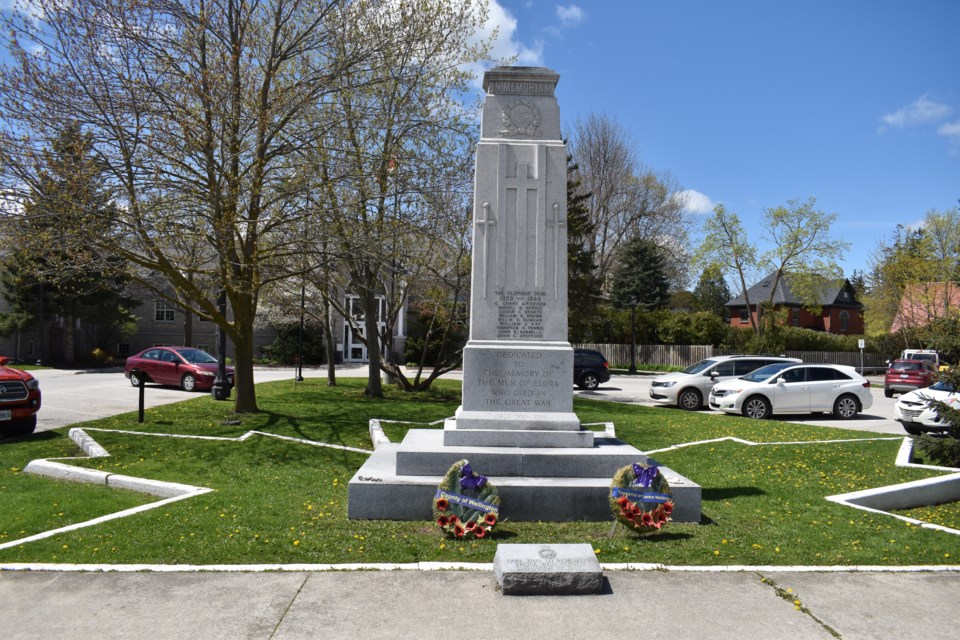Every year on Remembrance Day, across Canada people gather in front of cenotaphs like the ones in Elora and Fergus to honour the war dead whose names are engraved on them (and those whose names were, through some error, not included).
The word “cenotaph” is Greek for empty tomb, so a cenotaph is not a grave marker. Most of the people whom they commemorate lie in foreign graves, and some have no known graves.
One very important thing that must be remembered is that all of those names represent actual people. They once lived in our communities, attended the schools and churches, went to work everyday, walked the streets that we walk today. Behind every single name there is a life’s story.
Here are a few brief insights into the lives of some of the war dead of Elora and Fergus:
- Edward Grant Atchison (also spelled Aitchison) of Elora was a hardware merchant who enjoyed hockey, hunting and fishing. During the Second World War, he was a flight lieutenant in the RAF and then the RCAF. He flew missions over North Africa and Europe. On Feb. 7, 1945, he married Bronwen Mary Morgan, a Welsh nurse he met in the UK. Less than two months later, at age 26, Atchison was killed in action during air operations over Germany.
- Hiram Card and his daughter Winnifred, both of Elora, received the sad news that their son and brother, Pte. Daniel O. Card, had been killed in the battle of Vimy Ridge on April 9, 1917, during the First World War. Not quite seven months later, they were notified that Daniel’s brother, Sgt. Charles A. Card, was also killed in action in France.
- Gordon D. Anderson of Fergus had already put in many hours of flying time at the Kitchener airport when the Second World War broke out, so it seemed logical that he would join the RCAF. He served as an air gunner. In November of 1941 his plane was damaged while in action over German territory. Upon return to England, it crash-landed. Anderson was taken to Princess Mary’s Royal Air Force Hospital, where he died from his injuries on Nov. 19.
- Jack Edward Bailey of Elora left his farm in September of 1939 to enlist in the Canadian army when the Second World War broke out. He was not sent overseas until October of 1941. Pte. Bailey was fighting in Italy when on May 28, 1944, he was killed in action. Twenty-nine-year-old Bailey left behind his wife Mary (nee Hutchinson) and daughter Gloria Ann.
- John “Jack” Allan was born in Ireland but immigrated to Canada and settled in Fergus. He was employed as a railway brakeman. In October of 1915, he joined the Canadian Expeditionary Force (CEF) and went to France to fight in the First World War. On May 13, 1917, he was working with some other soldiers behind the lines when an enemy artillery shell exploded in their midst. Allan was killed instantly.
- Russell Beirnes was born in Hamilton but at the time he enlisted in the Canadian Army in 1939, he was living in Elora where he was employed at Mundell’s furniture factory. His mother, Hazel, lived in Fergus. Pte. Beirnes was a rifleman with the Canadian troops who stormed ashore at Juno Beach on D Day, June 6, 1944. On June 24 he was wounded in the hip and sent to a hospital in England. He wrote to his mother that he was healing quickly, and was anxious to get back in action so he could “lick the hell out of Hitler for what he gave me.” When Beirnes had recovered from his injury he was sent back into the fighting in France. His luck ran out on July 18 when he was killed in action. He was 21 years old.
- William H. “Dud” Brown of Elora, a foreman in a Fergus machine shop, was old enough to have stayed home instead of volunteering for wartime service. He and his wife Wilma (nee Storey) had a son and a daughter. But in 1940 Brown enlisted in the Canadian Army Provost Corps and served in England as a military policeman (MP). In November of 1945, while stationed in Surrey, Staff Sgt. Brown was hospitalized with heart problems. He died on Dec. 8 at age 41.
- Robert G. “Nick” Carter was known as a champion lacrosse player in his hometown of Elora. When the First World War broke out, he immediately volunteered for the CEF and was sent overseas with the First Canadian Contingent. However, he would never see the battlefields of France and Belgium. Those first Canadians to be sent to the war were initially encamped in substandard conditions on England’s Salisbury Plains, where they endured the coldest, wettest winter local people had ever known. Carter was one of the many who fell victim to sickness. On March 26, 1915, he died from meningitis at the age of 22.
- Lloyd Walter Young and William John Courtney of Fergus were killed within three days of each other in France in 1918; Young on April 2 and Courtney on April 5. Both were farmers and both were 24 years old. Young had just got married before volunteering for the CEF.
These brief anecdotes are but a few of the true-life stories of people from Elora and Fergus who made the ultimate sacrifice. Many more can be found on the website of Wellington County Museum and Archives under the headings “Collections and Research”, “Wellington County Remembers: Commemorating Our Fallen.”



